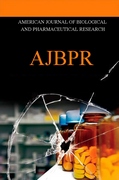Volume 12, Issue 1, 2025

Mcmed International
American Journal of Biological and Pharmaceutical Research
Issn
2348 - 2176 (Print),
2348 - 2184 (Online)
Frequency
bi-annual
Email
editorajbpr@mcmed.us
Journal Home page
http://mcmed.us/journal/ajbpr
Recommend to
Purchase












